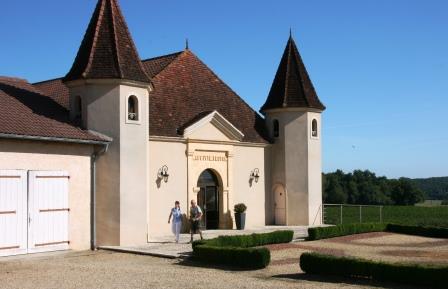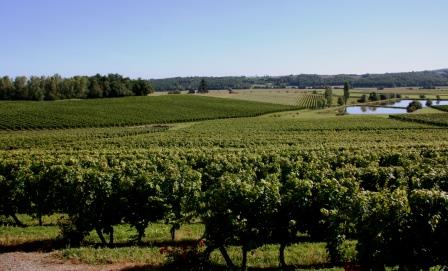Over the years several producers in Madiran have stood out for me. My favourite independent producers are Château Barréjat, Domaine Berthoumieu, Domaine Capmartin and Château Lafitte-Teston. (Despite their very considerable reputation, the Brumont properties, Montus and Bouscassé have never appealed to me to quite the same extent.)
Although I’ve tasted their wines many times, I’m rather embarrassed to admit that it was not until last week, on the most perfect of late summer mornings, that I found time to visit Château Laffitte-Teston for the first time. I wasn’t disappointed.
It is an immaculately-kept property of around 40 hectares, with spacious cellars amply filled with a lot of new oak barrels. A friend in the trade suggested to me that with a name like Laffitte (even with the different spelling) it aspires to being somewhat Bordelais. If this means that the wines incline towards elegance rather than power, as indeed they do, this only adds to their attraction as far as I’m concerned.
The two IGP Côtes de Gascogne with which we began have only a very gentle regional accent. Domaine Teston Rosé 2013, a blend of Cabernet Franc, Cabernet Sauvignon and Tannat is dry, crisp and juicy, with vivid strawberry and other red fruit aromas. The unoaked red Domaine Teston 2013 is a blend of roughly half Merlot, half Tannat and is full of bright, sappy red and black fruit, with crisper acid than one might expect from Merlot alone, but with rather more tannin. It is clearly designed to be enjoyed young and vibrantly fruity.
The estate’s Madiran is unmistakably Gascon. The aptly-named Reflet du Terroir 2011, with around 80% Tannat and 10% each of Cabernet Franc and Cabernet Sauvignon is from vines up to 55 years old and is aged for about a year in second fill barrels. The rich elderberry aromas of Tannat integrate well with the oak and the palate is elegant, balanced and persistent, but with more powerful acids and tannins than the IGP. Madiran Vieilles Vignes 2010 from vines around 70 years old is aged a little longer in all new oak. Once again the fruit is to the fore – elegant and perfumed. In the mouth it is rich and ripe with depth and power.
The dry white Pacherenc du Vic-Bilh Cuvée Ericka, named after owner Jean-Marc Laffitte’s daughter, is outstanding. It is unusual in being dominated by Petit Manseng (Gros Manseng is more usual in dry Pacherenc) and in being fermented and aged in new oak barrels, with regular lees stirring throughout its time in oak. The 2012 which we had also enjoyed with food the previous evening at the excellent Relais de Bastidou shows both elegance and complexity with clear, bright fruit. Grapefruit was evident when it was served cool at the restaurant, more exotic stone fruits were suggested as it warmed in the glass and opened up. It has very crisp acidity, a less creamy texture that the extent of lees working might suggest and a long finish, the only time when the new oak aromas come to the fore.
Pacherenc Moelleux, ‘Rêve d’Automne’, 100% Petit Manseng, is also fermented and aged in new oak barrels with a similar level of lees working. The 2012 is very concentrated, but not overly sweet and the fruit is balanced by very clean acidity. Once again the new oak is judiciously handled and does not dominate. Although the grapes are, of course, raisined on the vine, not botrytised, there is a distinct aroma of apricot.
The two final wines in the range, both made by mutage with alcohol and aged in oak casks for a year are great fun: Teston ‘Vintage’ Tannat and Petit Manseng. Both are 17% abv. The Tannat shows the sweet concentrated elderberry flavour of the fresh fruit, along with its unmistakable, earthy tannins; the Petit Manseng, with subtle oxidative notes and an intriguingly bitter phenolic kick at the end is like super-charged quince, balanced by mouth-watering acidity. Although there have been other attempts in the region to make a port-like Vin Doux Naturel with Tannat, this is the first I have tasted to feature Petit Manseng and is an unqualified success.
Château Laffitte-Teston wines are available in the UK at The Sampler, in London and through Balcony House Cellars in Sherston, Wiltshire.


